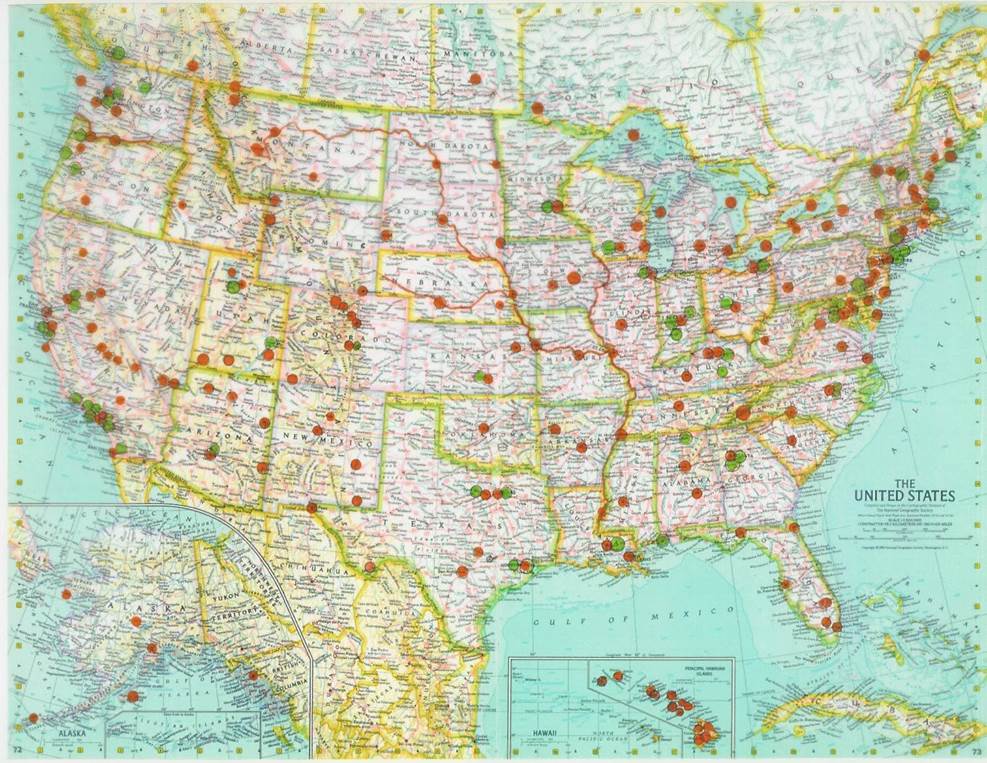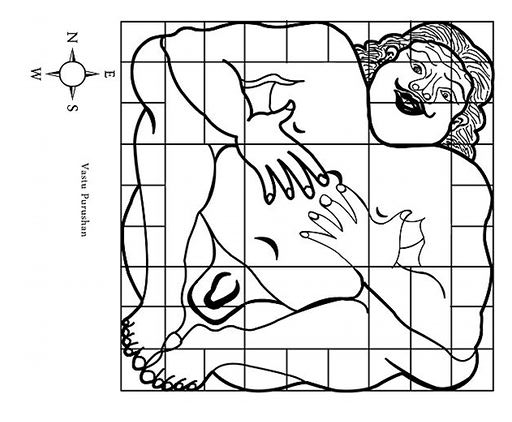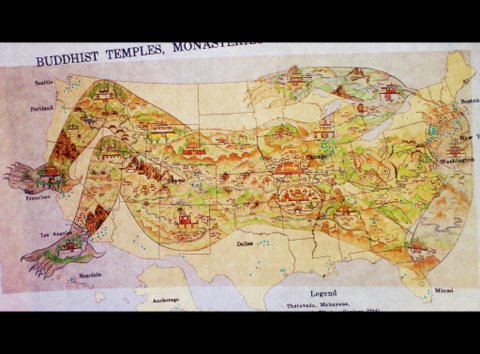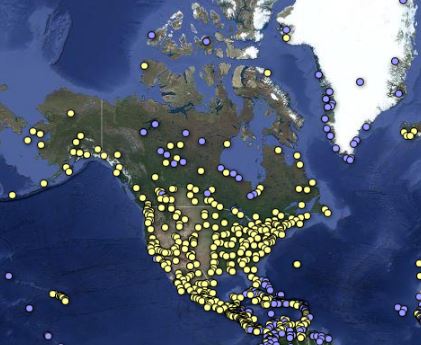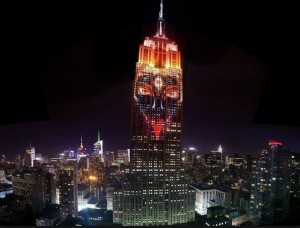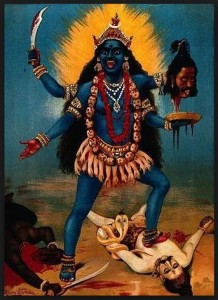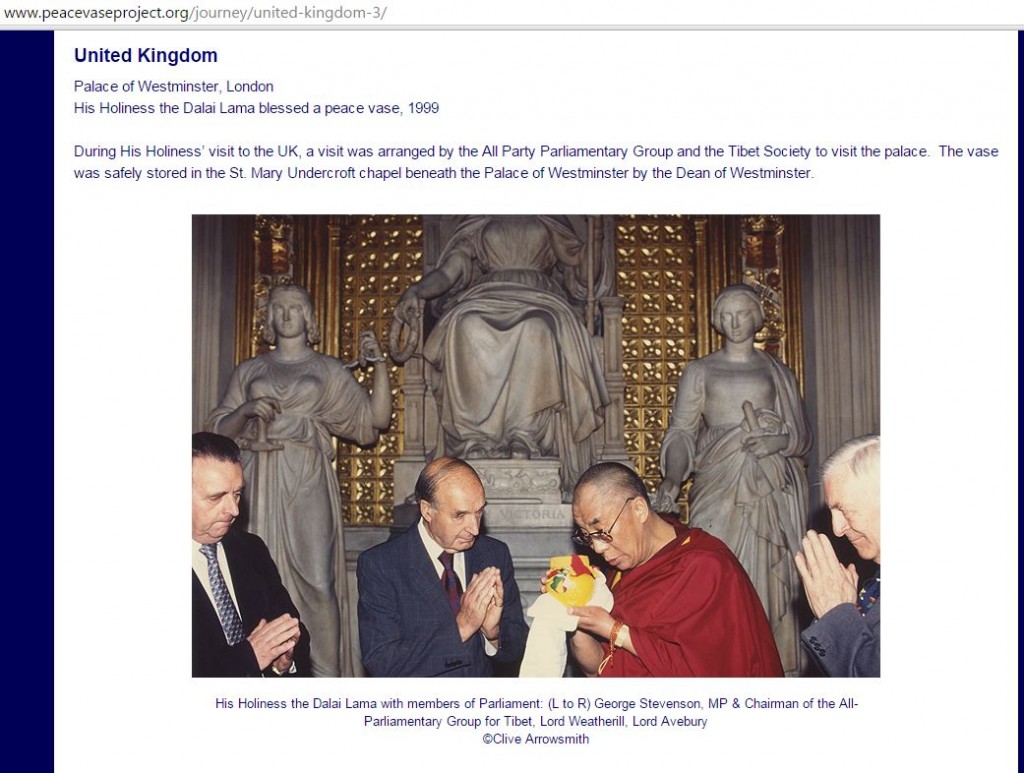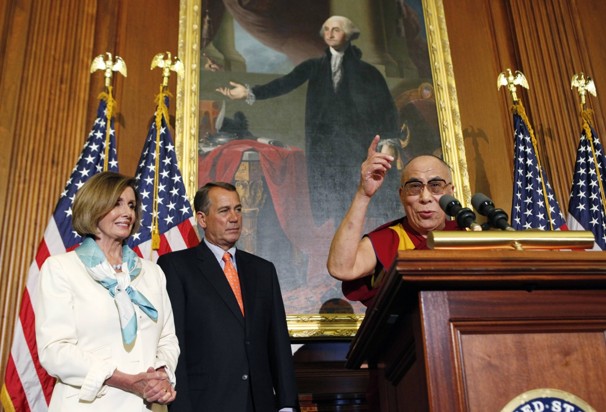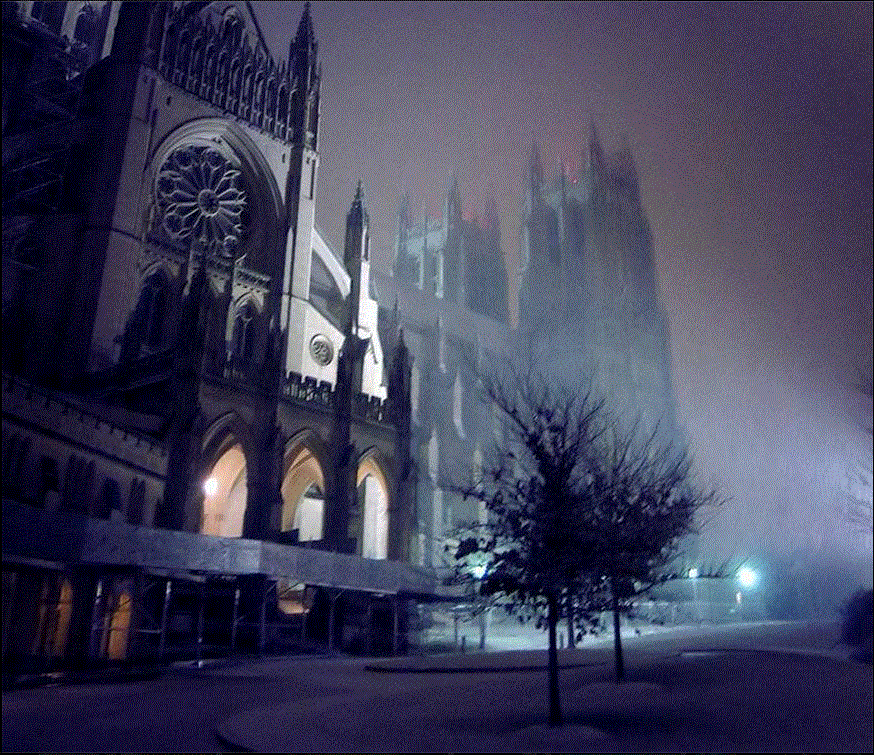 Dalai Lama and 9/11 and Beyond
Dalai Lama and 9/11 and Beyond
(Note: Since my Mandarin is only rudimentary, please let me know if this “anonymous translation” is accurate and not utilizing our interview for other purposes. I am somewhat cautious. Thank you. James Stephens).
4 December 2008
The following is core text of an interview with Victor and Victoria Trimondi (Germany) by James C. Stephens on September 11, 2003 and its Chinese translation. The article was credited to James C. Stephens and the Chinese translation shall be credited to an anonymous individual. The interview highlights the importance of distinguishing Tibetan Lamaism from the genuine Buddhism.
Trimondi:
We first met the XIV Dalai Lama in the eighties and became friends while publishing his writings in our publishing house, Trikont-Dianus-Verlag. While organizing international conferences with him and other famous speakers on interreligious and intercultural topics and specifically securing governmental level invitations to Germany and Austria for him, we began to seriously explore Tibetan Buddhism. However, after many years of extensive study and reflection, we seriously questioned some of the fundamental tenets of the “Tantric Buddhism” (which is in fact Tibetan Lamaism that is not recoganized by majority followers of the true Buddhism in the world – multipletext.com) the Dalai Lama professed and eventually became one of his sharpest critics.
我们在八十年代首次遇见十四世达赖喇嘛,并通过在我们的出版社出版他的文章而与他成为朋友。在和他以及其他著名的发言人组织关于跨宗教,跨文化的国际会议的时候,尤其是在确保他获得德国和奥地利政府的官方邀请的时候,我们开始认真地了解藏传喇嘛教。但是,在多年的广泛研究和思考之后,我们质疑达赖喇嘛宣扬的喇嘛教的一些基本信条。最终我们成为他最严厉的批判者之一。
Frankly speaking, the Dalai Lama has two faces. He makes his official contact with the West under the maxim of Mahayana Buddhism and then deftly assimilates the highest values and ideals of western culture. Through diplomatic tolerance he wins Agnostics as well as the hearts of unsuspecting Jews and Christians, to whom he preaches in the tongue of “a man of peace” and as a human rights activist relates passages of “compassion, love, and non-violence” from the “Sermon on the Mount.” Nearly all of the speeches the Dalai Lama delivers in public are extremely tolerant, human and compassionate. You can only agree. And yet, there is another face that peeks out from behind the mask of goodness, charity and kindness, which gives one pause to think more deeply about the shadow of this ‘man of peace.”
坦白的讲,达赖喇嘛有两张面孔。他以大乘佛教的名义与西方接触,然后有技巧的吸收西方文化的价值和理想。通过富于外交性的容忍态度,他赢得了不可知论者和毫无戒心的犹太人及基督徒的心。对这些人,他以和平主义者和人权运动家的腔调布道,谈及“山中布道”中关于 “同情,爱,和非暴力”的段子。几乎所有达赖喇嘛在公共场合发布的演讲都非常的宽容,有人情味,富于同情心。你只能同意。但是,在这张正义,慈善和友善的面具下,却有另一张面孔。这张面孔使人停下来深入的思考这个“和平主义者”的阴影。
The XIV Dalai Lama, the God-King of Tibet is the highest representative of Tantric “Buddhism” [this representative is in fact not recognized by other branches of Tibetan Lamaism – multipletext.com], established in Tibet in the 8th century, A.D. Tantrism, the last stage in the history of Buddhism (since the 5th century A.D. in India) is based on ritual and magic formulas. Not unlike other religions it also has “skeletons in its’ closet” which it carefully conceals as a guest in the Western world. Tibetan Tantrism is a belief in spirits and demons, secret sexual practices, occultism, mind control, and an obsession with power. In contrary to every democratic custom, the present Dalai Lama consults with the Nechung Oracle, a monk who is possessed by a Mongolian war God, on all important state decisions.
十四世达赖喇嘛是喇嘛教的神王。喇嘛教建于公元8世纪, 是基于仪式和魔法公式的。和其他宗教没有不同,它也有“壁橱里的骷髅”。但是它在西方作客时仔细地把这一点给掩盖了起来。喇嘛教是一种对灵异魔鬼,秘密性交、神秘主义、精神控制和权力崇拜的信仰。与每一个民主团体的习惯相反,现在的达赖喇嘛在所有重要的国家决策上都求助鬼神谕,一个被蒙古战神附体的僧侣。
What primarily concerns us about the interreligious ceremony in the National Cathedral in Washington, D.C. is the level of naivety in the West. For the past 25 years, the Dalai Lama has quietly performed the Kalachakra Tantra (“The Wheel of Time”), the highest of all ancient Tantric initiations for tens of thousands of spiritual novices in the West; introducing Tantric ideology, secret sexual practices, and magic rituals integrated into the context of his religious-political worldview. Critical voices have been raised, while he continues to secretly transmit the Kalachakra’s prophetic vision of the establishment of a universal Buddhocracy (Shambhala) in which spiritual and worldly power are united in one person, the “world emperor”(Chakravartin), wherein other religions will no longer exist.
我们对于在华盛顿特区的国家大教堂举行的跨宗教仪式的最大忧虑,是西方天真的程度。在过去的25年,达赖喇嘛不事声张地对西方成千上万的宗教新人举行着时轮大法这一古代喇嘛教所有灌顶方式中的最高形式,把喇嘛教信仰,秘密的集体淫乱和魔法仪式整合进他的宗教-政治世界观中。他继续秘密地传播着时轮的预言,预言一个无所不在的喇嘛教统治–香巴拉。在这个喇嘛教治之下,所有精神的和世俗的力量都集于一人–世界皇帝,而其他的宗教都不再存在。
Stephens:
Who are these “non-Buddhist” (non-Lamaist) enemies spoken of in the Kalachakra Teachings? I’ve seen articles in the Buddhist magazines the Shambhala Sun and Tricycle about Lamas dressing up in military uniforms. I thought Buddhism was a peaceful faith.
谁是那些在《时轮大法典籍》中提到的非喇嘛教徒敌人?我已经在佛教(?)杂志《香巴拉之日》中看到了穿着军事制服的喇嘛们。我过去曾以为佛教是一种平和的信仰。
The secret text of the Kalachakra explicitly names the “leaders” of Judaism, Christianity and Islam as the opponents of Buddhism: “Adam, Enoch, Abraham, Moses, Jesus, Mani, Muhammad and the Mahdi” describing them as “the family of the demonic snakes” (Shri Kalachakra I. 154).
时轮大法预言了一个喇嘛教帝国的建立和喇嘛教的军事力量对非喇嘛教的宗教所发动的战争。时轮的秘密典籍明确地把犹太教,基督教和伊斯兰教的领导人提出来作为喇嘛教的敌人。
Over the last five years in the German speaking countries, these shadow-aspects of Lamaism have lead to a vast, steady and increasing stream of criticism in the media. During the Kalachakra-Initiation of the Dalai Lama last year in Austria there were very controversial debates on TV and Radio Stations and Press Media. The internationally well known newspaper “Der Standard” published an article entitled “A Warrior Ritual with the Dalai Lama: The Kalachakra”. The German Weekly of Christian intellectuals “Der Rheinische Merkur” entitled an article: “What is hidden behind the Kalachakra Tantra? Supremely Ferocious Warriors!”
过去五年中,在德语国家里喇嘛教的这些阴暗面已经引起了媒体中日渐增加的批评。去年,当达赖喇嘛在奥地利举行时轮灌顶的时候,电台、电视、和平面媒体都有激烈的争论。国际著名的报纸发布了一篇名为“达赖喇嘛的武士仪式:时轮大法”的文章。德国的基督教知识分子周报也发表了一篇文章:“在时轮大法中掩藏者什么?超级狂战士!”
As in the Islamic martyr-ideology Shambhala-Warriors, who will be killed in the last battle have earned passage into the “Buddhist” (Lamaism) paradise.
正如伊斯兰的烈士信仰一样,在最后一战中死去的香巴拉武士将获得通向喇嘛教天堂的通行证。
The military scenarios in some “Buddhist” Centers such as the Shambhala training camps of the deceased Lama Chögyum Trungpa, have until now only a symbolic meaning, and yet they are interpreted as a spiritual preparation of the prophesized great Shambhala War. In the imagination of some Lamas all participants in a Kalachakra initiation have the questionable privilege of being reborn as “Shambhala Warriors” in order to be able to participate in the coming apocalyptic battle either as infantry or officers, dependant on rank. High lamas of particular lineages have already been assigned to commanding positions in the future.
到现在为止,在某些喇嘛教中心出现的军事场景还只有象征意义,但这些场景已被解读为对预言中伟大的香巴拉战争的一种精神准备。在某些喇嘛的想像中,所有时轮灌顶的参加者都有重生为香巴拉武士的可能性。他们将参加即将到来的末日大战。依据阶级,他们将成为普通士兵或者军官。某些血统的高级喇嘛已经被赋予未来的指挥职务。
Stephens:
Of late, the scandal of sexual abuse among Catholics and other Christian clergy has hit the news. I recall that a number of years ago, we spoke to members of Dharmadhatu in West Hollywood who openly mentioned that their founder Osel Tenzin had knowingly infected many of their members with the aids virus and that nine lamas had died in Boulder, Colorado. We were humbled by their vulnerability on the subject. They obviously felt terribly violated. Another Christian woman we met in Seattle who was formerly a sexual consort to a local Tibetan lama was so severely wounded by her experience that she would not even speak of it in detail.
最近,新闻报道了在天主教和基督教的神职人员中发生的性虐待丑闻。我记得许多年以前,我们曾和位于西好莱坞的大麻哈土的成员谈过话。他们公开提到他们的创建者曾故意用艾滋病毒去感染大麻哈土的很多成员,他们还提到九个喇嘛在科罗拉多首府死去。我们为他们在此事上的脆弱无助感到震惊。很明显地,他们感到被严重的侵害了。我们还曾在西雅图遇见过另一个基督妇女。她一度是一个当地的西藏喇嘛的性伴侣。她受的伤害是如此的深, 以至于她从不肯详细提起这些经历。
Trimondi:
Here in Europe, one of the most well known and discussed cases involved the Scottish Buddhist June Campbell and the attempt of her teacher, the most honorable eighty year old Lama Kalu Rinpoche, to misuse her sexually. The 10. February 1999 headline of the British newspaper The Independent read: “I was a Tantric sex slave.”
在欧洲这里,最广为人知并被广泛讨论的案例中包括苏格兰喇嘛教徒琼.坎贝尔。她的老师卡鲁仁波切,一位受人尊敬的八十岁的老喇嘛, 曾对她有过性侵犯。英国报纸独立报曾在1999年2月10日刊登头条:“我是一个喇嘛性奴隶。”
Campbell shows also in her confessional book Traveller in Space that the sexual misuse of women is not only a blameable attitude but that it is a central part of the Lamaist Tantric religion. The sexual magic practice exercised by a Lama with a woman has the specific goal to transmit the erotic and female energy into the spiritual and worldly power of the male partner. Such sexual rituals are the core of Tibetan Buddhism. Also in the secret higher initiations of the Kalachakra Tantra sexual magical rites take place. The ritual texts can be interpreted symbolically or real (!). Both are possible. The originals say that eleven-year-old girls may be used as sexual partners.
坎贝尔在她自己自白性的书《空间的旅行者》中提到,一个喇嘛对女性的性行为有着一个明确的目标:把女性的性能量传入男性伙伴的灵与肉中。这些性仪式是藏传佛教的核心。在时轮大法的更高级的灌顶仪式中,也可以看到带有魔法意味的性仪式。这些仪式的书面描述可以做象征性的解释,也可以做字面上的解释, 两种都行。原文说11岁的女孩子可以用来作为性伴侣。
Trimondi:
It’s really shocking, in the “SS-Ahnenerbe“, which was the academic brain trust of the SS, that its’ Chief Heinrich Himmler, was openly engaged in ongoing discussions with the most distinguished German Orientalists of his time in the construction of a new Indo-Arian Nazi-Religion. After WW II this discussion was continued by prominent neo-fascist ideologues.
真正让人吃惊的是,在“党卫军的智库“,海因里希·希姆莱公开地与他那个时代最“杰出“的东方学家讨论建立一种新的印度–雅利安纳粹宗教。在二战后,这种讨论为主要的新纳粹主义分子所继续。
Stephens:
I recall attending the Simon Wiesenthal Museum of Tolerance in 1996 when the Dalai Lama was awarded “The Simon Wiesenthal Peace Prize” and the director equated him with “Aaron, our man of peace.” What should the Jewish community be concerned about in light of your research on his connections with Nazism?
我还记得在1996年,赛蒙伪三叟博物馆授予了达赖喇嘛“赛蒙伪三叟和平奖“。当时的赛蒙伪馆长将达赖称为“亚伦,我们的和平者“。从你对他和纳粹主义的联系的研究来看,犹太社区应该对什么感到担心?
Trimondi:
It is a fact that the Shambhala War Ideology of the Kalachakra-Tantra has led to aggressive behaviour, megalomaniacal visions and conspiracy theories both in the history of the Asia as well as in that of religious fascism and neo-fascism. Already in the SS-Ahnenerbe, where Heinrich Himmler’s Nazi-Religion was born, there was an interest in the contents of the Kalachakra-Tantra. The influential fascist and cultural philosopher Julius Evola saw in the mythic world of Shambhala an esoteric centre of a sacred warrior race. This vision is today still firmly anchored in the religious ideas of the international far-right movement. That alone makes it necessary for the Dalai Lama to distance himself clearly from the war-mongering Shambhala Myth.
一个毋庸置疑的事实是时轮大法关于世界战争的意识形态于历史上已经在亚洲和宗教法西斯主义及新纳粹主义中导致了过激的行为,妄想,和阴谋论。在作为海因里希·希姆莱的纳粹宗教诞生地的党卫军的智库,时轮大法的内涵曾引起人们浓厚的兴趣。著名的法西斯分子和文化哲学家聚勒司·挨废拉在神话般的香巴拉世界中看到了一个神圣的武士种族的中心地位。这种构想至今仍然在国际极右运动的宗教观念中占据了一席之地。光是这一条就足以要求达赖喇嘛和鼓吹战争的香巴拉之谜保持清楚的距离。

Instead of this he has cultivated friendly contacts with people such as the ex-SS men Bruno Beger (convicted as helping to murder more than 86 Jews) and Heinrich Harrer, author of Seven Years in Tibet (a chronicle of his experience with the Dalai Lama over seven years prior to his exile to India). The Homepage of the Government of Tibet in Exile (www.tibet.com/Status/statement.html) shows the XIV Dalai Lama between Bruno Beger on his right and Heinrich Harrer on his left. Beger has been a member of the famous SS-Tibet Expedition organized by the SS in 1938/1939 whose primary goal was to find traces of an ancient, lost indo-Arian religion in the Himalayas. Some occult leaders in the SS were convinced that Tibetan Lamas are the key holders of these Indo-Arian Mysteries. Beger is highly respected by the Government of Tibet in Exile as a chief witness for the political independence of the country in the 30‘s and 40‘s of the last century.
但他不仅没有这样做,反而与诸如布鲁诺·伯格和海因里希·哈尔一类的人建立了友好的联系。其中布鲁诺·伯格是前党卫军,被定罪帮助谋杀了超过86个犹太人人;海因里希·哈尔是《西藏七年》的作者(《西藏七年》讲述了他和达赖喇嘛在达赖流亡去印度之前的七年间的经历)。西藏流亡政府的网站显示了十四世达赖喇嘛站在布鲁诺·伯格和海因里希·哈尔之间。伯格是著名的党卫军西藏探险队在1938-1939年间的成员。这个探险队的主要目的是在喜马拉雅山地区找到一个古代失落的印度–雅利安宗教的痕迹。党卫军中的一些头目相信西藏喇嘛们掌握着这一印度–雅利安之迷的关键。伯格作为西藏在上一世纪三十和四十年代的政治独立运动的主要见证人,受到西藏流亡政府高度尊敬。

Nearly unknown until now are the contacts of the Dalai Lama with the French SS-collaborator, convinced anti-Semite, recognised Orientalist and Kalachakra Tantra Expert Jean Marquès-Rivière (in his absence convicted and given the death sentence for turning Jews over to the Gestapo in France). The founder of an esoteric Hitler movement the ex-Chilean diplomat Miguel Serrano (promoter of an extremely racist SS-mysticism, which is based on Tantric practices and on the idea of the Shambhala Warriors) met the Dalai Lama four times.
直到最近才被揭露的还有达赖喇嘛和基·麻克斯–锐非的联系。麻克斯是法国著名的东方学家,时轮大法专家,坚定的反犹主义者。他因为与党卫军合作,将犹太人交给在法国的盖世太保而被缺席定罪,判为死刑。一个秘密的希特勒运动的创始人,前智利外交家米盖儿·色锐耨也曾与达赖喇嘛会晤过四次。米盖儿是一个基于密宗和关于香巴拉武士的想法的极端种族主义社团的鼓吹者。

Well known became his relationship with the Japanese terrorist, Shoko Asahara, whom he described, even after the Tokyo sarin gas attacks, as his “friend, albeit an imperfect one”. Only later he did distance himself from the Guru. Asahara’s Doomsday Philosophy was mainly influenced by the Shambhala Ideology and by Tibetan Tantrism.
众所周知的还有他与日本恐怖分子麻原彰晃的联系。他把麻原彰晃描述为他的“朋友,尽管不完美“。这已经是在东京沙林毒气袭击之后。直到后来,他才与麻原彰晃疏远开来。麻原彰晃的末日论主要就是受到香巴拉意识形态和藏传喇嘛教的影响。
Hollywood films are the most powerful vectors of fantasy ever known to humankind. So the extensive and well known connection of the Dalai Lama with the film world and with famous actors and actresses is certainly an effective propaganda instrument. Since the nineties, Tibet, the Tibetan God King and Tibetan “Buddhism” have been glorified by the most prominent film-directors, neglecting even a minimum of critique of Tibet’s feudalistic and bloody past controlled by a despotic monk (lama) aristocracy with absolute power.
好莱坞电影是人类已知的最强有力的幻想。所以达赖喇嘛与电影世界和著名演员的广泛而又广为人知的联系就是一个有效的宣传武器。自从九十年代以来,西藏,西藏神王和西藏喇嘛教就被最有名的电影导演们所神化,而对于西藏被一个专制的僧侣贵族统治所绝对控制的封建制的和血腥的过去,哪怕是一点点的批评也被忽略不计了。
Bernardo Bertolucci’s “Little Buddha” or Martin Scorsese’s “Kundun” are constructions of a virtual Tibet, which never did exist. Even the ancient anti-Nazi tradition of the American film-fabric was broken, when Jean Jacques Annaud brought out “Seven years in Tibet”. This film with Brad Pitt is a mystification and hero worship of the former SS-man Heinrich Harrer who in the forties became the teacher of the young Dalai Lama. In his book Virtual Tibet (2000) Orville Schell details the “incredible” story of one of the most effective delusions in the film world: The Tibet Fantasies of Hollywood. Some other purpose than an art display? Why should we be concerned?
本拿多·本托虏西的“小活佛“或者麻钉·死搞嬉嬉的“困顿“构造了一个虚幻的西藏,这个西藏从来都没有存在过。甚至美国电影里一直存在的反纳粹的传统也在鸡·即刻死·按诺得推出“西藏七年“的时候被打破了。这部由不拉德·痞特主演的电影是对前党卫军海因里希·哈尔的神化和英雄崇拜。哈尔在四十年代成为年青的达赖喇嘛的老师。 厄非尔·谢尔在他的《虚拟西藏》(2000)一书中详细描述了电影世界所制造的最有效的幻觉:好莱坞的西藏神话。
The following is core text of an interview with Victor and Victoria Trimondi (Germany) by James C. Stephen on September 11, 2003 and its Chinese translation. The article was credited to James C. Stephens and the Chinese translation shall be credited to an anonymous individual. The interview highlights the importance of distinguishing Tibatan Lamaism from the genuine Buddhism.
I remember running into Richard Gere at the Wiesenthal Museum Peace Prize presentation and discovered that his Foundation has financed the building of over 300 sand Mandalas throughout the continental US. What exactly is a sand Mandala? Do these Monk’s Mandala tours have some other purpose than an art display? Why should we be concerned?
我还记得有一次在赛蒙伪三叟博物馆的和平奖颁奖仪式上遇到了理差鸡。我发现他的基金会资助了在美国大陆各地修建的超过三百个沙做的曼荼罗。曼荼罗到底是什么?这些喇嘛们的曼荼罗展览除了作为艺术展览之外还有什么目的?我们为什么应对此感到担心?
Trimondi:
A Mandala is a sacred pictogram; one also can call it a “magic circle”. It is an instrument to evoke the gods, goddesses and demons of the Tantric pantheon. For a modern Western approach, in which religion and arts are not yet unified, the Mandala is a work of art. However, in the Lamaist tradition where there is no difference between the aesthetic and the sacred and where art is always sacred art, the Mandala is a spiritual power vortex, an assembly point of gods and demons, a palace of the divine, a spiritual battery from where powerful energies are radiating. It is also connected with the Lamaist idea that the place, where the Mandala is erected, stands under the absolute control of its divine or, we would say, demonic “inhabitants”.
曼荼罗是一“种神圣“的图案;我们也可以把它叫做“魔力圆圈“, 被用来召唤密宗万神殿的神灵和魔鬼们。由于从现代西方的视角来看,宗教和艺术并非是一个统一体,所以曼荼罗被视为一种艺术品。但是在喇嘛教的传统里,审美与神圣并没有区别,曼荼罗被看作是一种灵塔,是神灵与魔鬼的汇聚点,是一种神殿,就象是一种精神电池,从其中可以发出强大的能量,曼荼罗建立之地被认为处于圣灵的绝对控制之下,或者说,在魔鬼的绝对控制之下。
The intricate Mandala, constructed during the Kalachakra Ceremony, is made with coloured sand and symbolizes the whole universe. At the end of the ritualistic performance the sand construction will be destroyed by the Tibetan monks. The so called “dismantling” of the sand Mandala symbolizes the destruction of the world and of the universe. This is part of the apocalyptic Doomsday Scenarios in the Kalachakra prophecies which culminate in a final battle and the End of our planet. Nevertheless the construction and destruction of the Mandala is presented by the Dalai Lama as a contribution to world peace.
在时轮仪式中,繁复的曼荼罗是用彩色的沙建造的,象征着整个宇宙。在仪式结束时,沙曼荼罗会被西藏喇嘛们摧毁, 象征着整个世界和宇宙的毁灭 – 这是时轮预言中关于末日理论的一部分,这一末日理论预言了一场最终之战和星球的毁灭。然而,曼荼罗的建造和毁灭却被达赖喇嘛包装成对世界和平的贡献。
Although one would desire to believe in its peace producing energy, realistically one has to accept, that the construction of this magic circle after more than 25 years in the West has brought no more appeasement to the people than it did in Tibet which has suffered much. The aggressive and terrorist energies have become more and stronger in our world and the clash of religions has become an everyday-problem in politics. Is it not evident that the construction of 300 sand Mandalas throughout the U.S. you are speaking of has not contributed peace to this country? History on the contrary has proceeded in the opposite direction and is on the way of destruction and war.
尽管我们想要相信曼荼罗能够产生和平的能量,我们却不得不接受这一事实:自魔力圈在西方被建造起来的25年里,它并没有给人们带来比它在西藏给人们带来的更多的欢乐。在我们的世界中,激进的和恐怖主义的能量越来越多,越来越强,宗教冲突已经成为家常便饭。显而易见,你提到的遍布美国的超过三百个的曼荼罗并没有给这个国家带来和平,历史正朝相反的方向前进,走向战争和毁灭。
In our studies it was alarming to find that following the first World Trade Center bombing in 1993 a Wheel of Time (Kalachakra) Sand Mandala was built in the lobby of Tower One. For over thirty days, many of the World Trade Center workers and visitors were invited by the Tibetan Monks to participate in the construction of this Mandala. When the Dalai Lama visits New York in the next days, we would ask: Why the terrible event of 9/11 could happen at the World Trade Center that was consecrated by the so called “Circle of Peace,” the Kalachakra Sand Mandala, the same mandalas that were unable to prevent the destruction of 7500 monasteries of Tibet? In this context a sentence of the Tantra expert and Indian scholar Shashi Bhusan Dasgupta may be remarkable: “The word Kala means time, death and destruction. Kala-Chakra is the Wheel of Destruction.”
我们在研究中不安的发现,在1993年世贸大楼遭到第一次炸弹袭击之后,一个时轮沙曼荼罗在一号楼的大厅里被建造起来。在超过三十天的过程中,许多世贸大楼的工作者和游客被西藏喇嘛们邀请参与这个曼荼罗的建造。当达赖喇嘛在随后的几天中访问纽约的时候,我们想问:为什么911那样可怕的事件最终还是发生了,尽管世贸大楼被所谓的“和平之轮”这一时轮沙曼荼罗所庇佑着?别忘了这些同样的曼荼罗并没有保护西藏的7500个喇嘛庙不被摧毁。在这一背景下,时轮大法专家,印度学者沙士的一句话就显得令人震惊了:“时意味着时间,死亡和毁灭。时轮就是毁灭之轮。”
We just did find in the Internet a statement of a participant of the WTC Kalachakra Ceremony, which seems really revealing especially because it is made by an initiand of the Tantra: “The topic shifted to the Kalachakra Mandala that was made at One World Trade Center. I was at the dissolution ceremony there, may be around ’96. The monks gathered up all the sand from the Mandala at 1WTC, put it in a vase, then carried it across the bridge into World Financial Center through the Winter Garden, then dumped the sand ceremoniously into the Hudson River for the sake of World Peace. The surface of the river glittered with the afternoon sun, and I cried. 5 years later, the whole building is gone, just like the sand Mandala.”
我们在互联网上找到了一个当年世贸大楼的时轮大法仪式的参加者的话,这些话看起来意味深长, 暗藏天机:“话题转换到一号楼的时轮曼荼罗上。我当时也在降解仪式上,时间大概是96年。喇嘛们把所有的来自一号楼曼荼罗的沙都搜集起来,放入一个瓶子里面,然后把瓶子通过冬园带过通向世界金融中心的桥,然后郑重其事地把沙倾入哈德迅大河之中,祈求世界和平。当时河面上闪烁着午后阳光,令我感动流泪。五年以后,整座大楼都消失了,就象沙曼荼罗一样。”
Stephens:
From your experience in the Kalachakra Debate in Europe and your observation of mass media’s romantic portrayal of Tibet, what are the potential dangers to other faiths, including Buddhism and democracy of this growing Shambhala myth?
从你在欧洲关于时轮大法的辩论的经验和对媒体对西藏浪漫化的描述的观察来看,哪些是对其他信仰的危险.
Trimondi:
The danger lies in that the Kalachakra Tantra ritual subtlety builds an ideological foundation for a future “war of religions.” If the problematic contents of this archaic belief are not openly discussed, they may present a dangerous ideological challenge to the positive legacy of Western Civilization and Democratic institutions. There is also no doubt that the Kalachakra ideology proposing the establishment of “Buddhocratic” rule, a universal Emperor (Chakravartin) , violence, the licence to kill and the waging of a “Buddhist” holy war are in direct opposition to the original peaceful teachings of Sakyamuni Buddha. Concerning this discrepancy between the aggressive contents of the Kalachakra Tantra and the original peaceful Dharma, taught by the historic Buddha, we have formulated Eight Questions to the Dalai Lama.
危险在于时轮大法的仪式为未来的“宗教战争”巧妙地提供了一个意识形态的基础。如果这个充满问题的远古喇嘛信仰的内涵不被公开讨论的话,它们也许会在意识形态上对西方文明和民主制度的正面遗产提出危险的挑战。在时轮大法的意识形态中提到的喇嘛教统治,一个世界之神,杀戮的自由以及发动喇嘛教圣战,在在都与真正佛教的和平教诲背道而驰。关于时轮大法暴力与独裁本质与佛祖教诲及大乘佛教的根本性区别,我们向达赖喇嘛提出了八项质问。
Stephens:
Serious talks of the Dalai Lama’s return to China before the Olympics are beginning to leak into the media. How will this impact the future of the West?
关于达赖喇嘛在奥运会之前回到中国的严肃讨论正渐渐见于媒体。这将如何影响西方的未来呢?
Trimondi:
We are really uneasy, if you ask us, as to what may potentially happen if this “Buddhist”-Jihad-Ideology” of the Kalachakra Tantra will become a new vision of the Chinese political self-understanding. Will the much more peaceful and softer philosophy of Daoism and Confucianism be replaced by the “Shambhala Warrior Doctrine”, which was once propagated in thirties by the Japanese Shinto-Fascists to mobilize the Mongolian minorities of Manchuria and West China? If the present situation in Europe is any indicator, we must say that we are alarmed as we witness the rising interest in Germany of Fascist, Neo-fascist and Nazi-intellectuals and in Asia of a terrorist like the Japanese Doomsday Guru Shoko Asahara in the ideological concepts of the Shambhala War of the Kalachakra Tantra. This should be a Menetekel, that the “writing is on the wall” as a major wake-up call for the West.
我们感到很不安。如果这种“喇嘛教–圣战”的意识形态成为中国政治新理念的话, 平和理性的道家和儒家学说是否会被这种 “香巴拉武士教条” 所取代呢?在三十年代,日本神道–法西斯分子曾利用东密来动员满族和蒙古族少数民族参与分裂中国的战争。当我们目睹德国法西斯分子,新法西斯分子,纳粹知识分子以及亚洲的恐怖分子(如日本的麻原彰晃)对时轮大法的香巴拉战争的兴趣日益增长时,我们不得不因此而充满戒心, 并向西方敲响警钟。
If you are interested in further information on the subject of the “Dalai Lama and Tibetan Buddhism, ” we have prepared an extensive online multimedia course available at http://www.worldviews101.com.
For interviews and speaking engagements, please contact admin@worldviews101.com.

